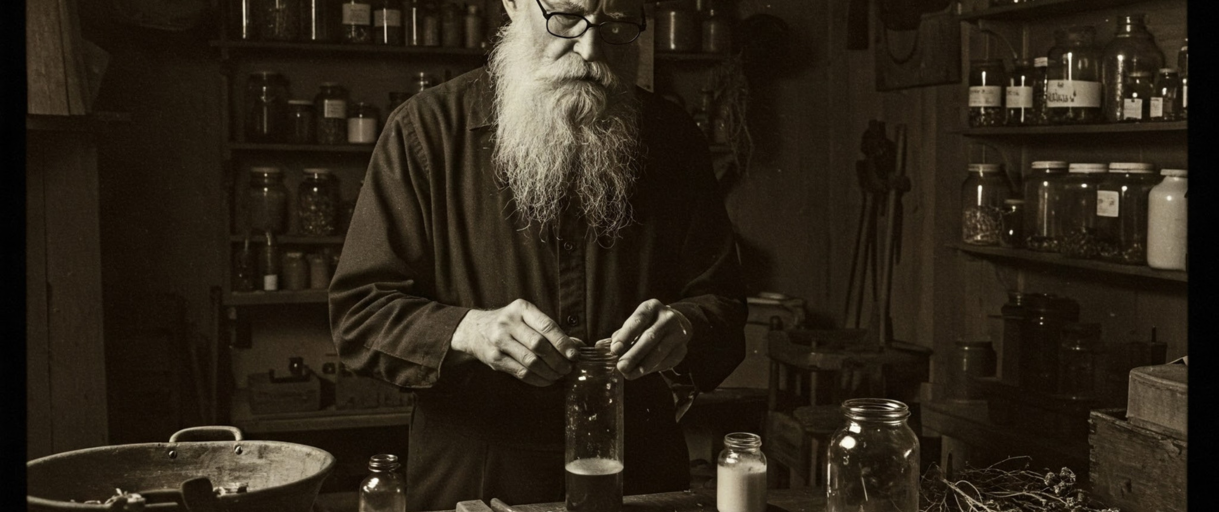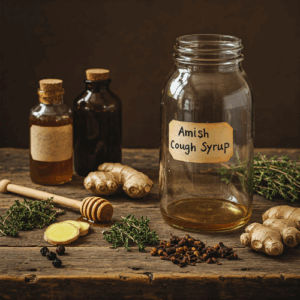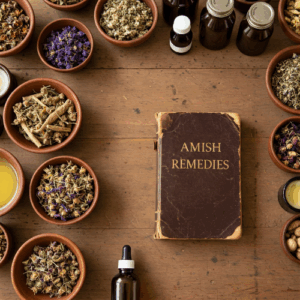The Amish are a very close-knit community. To be more specific, they are often a very closed community typically shunning the influences and temptations of the outside world. They are highly self-sufficient and that includes medical treatments.
They will seek professional medical help when the affliction is serious or life-threatening, but for the most part they depend on their own home remedies to treat the everyday illnesses that send most of us to the drug store for an over-the-counter medication or even a prescription. There are also lifestyle factors that affect their overall health and well-being. These include:
- The Amish are very physically active
- They tend to eat organic, home-grown fruits, vegetables and livestock
- They don’t smoke
- Their communities tend to be calm and serene and highly supportive
- There appears to be a healthy genetic predisposition within the population
But in spite of anyone’s best efforts, everyone gets injured, comes down with a cold or flu, and endures the afflictions that come with age and time. Their response to these common occurrences often falls in the category of herbal medicines and simple physical treatments to treat injuries and illness. It’s a good lesson for anyone who wants to approach health issues without the side-effects of medications or is in a situation where standard medical treatments are not available.
The 10 Amish Medical Hacks
Here are the 10 Amish Medical alternatives that we’ll cover:
1. Pain relief
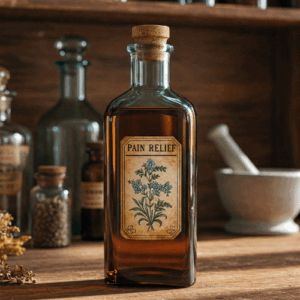
The Amish use the root of the poke plant (pokeweed) and dry it and reduce it to a powder and apply it to the feet. They claim it removes pain anywhere and everywhere in the body.
If you don’t happen to have any pokeweed growing in the area, there’s another alternative for pain relief. It’s the go-to pain elixir the Amish rely on using basics like dandelion flowers, leaves and roots and rosemary leaves seeped in apple cider vinegar. It takes a couple of weeks to make but if stored in a dark glass bottle, it will keep for months in a refrigerator or root cellar.
- 1 cup of fresh dandelion flowers (petals only) plus dandelion leaves and washed roots all coarsely chopped.
- ½ cup of fresh rosemary leaves (needles) coarsely chopped
- 2 cups of raw apple cider vinegar with the “mother”
- A glass mason jar with a tight-fitting lid
- Cheesecloth or a fine mesh strainer
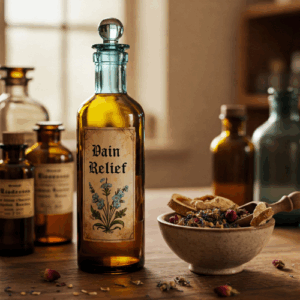 To make your Amish pain elixir coarsely chop the dandelion petals, leaves and roots and rosemary leaves and drop into the jar. Pour the apple cider vinegar over the mixture and seal the jar in a cool, dark place. Avoid sunlight. A refrigerator is a good place for it or the root cellar.
To make your Amish pain elixir coarsely chop the dandelion petals, leaves and roots and rosemary leaves and drop into the jar. Pour the apple cider vinegar over the mixture and seal the jar in a cool, dark place. Avoid sunlight. A refrigerator is a good place for it or the root cellar.
You then gently swirl or shake the jar (not sure what’s gentle about shaking) at least once a day. Wait two weeks and strain the liquid through cheesecloth or a fine mesh strainer into your dark, glass bottle. You can drink it but also use it as an application directly to any painful areas. You could also soak a small washcloth, towel or clean rag and heat it gently to make a warm compress. If you want to take it orally, add one to two tablespoons to a glass of water (you might want to add some honey) and drink as needed.
The Amish even have a secret, natural cure for migraines. They peel and slice a raw potato and put into a blender or juicer to get the juice. The juice is strained through cheesecloth or a fine-mesh strainer and pour into a glass of warm water. It’s the potassium in the potato juice that relieves the migraine.
2. Fever reducer
The Amish use the inner bark (cambium layer) of the white willow tree added to water and honey as both a pain reliever and fever reducer. The chemical salicin in the willow bark is the active ingredient in all aspiring but instead of buying it, they brew their own. The water is brought to a boil and the bark allowed to soak for ten minutes. Honey is added to improve the taste, and it also has some medicinal properties.
When it comes to breaking a stubborn fever, especially in children, the Amish often turn to a remedy that might sound strange at first: fever socks. It’s a simple, old-fashioned method that’s surprisingly effective.
It might sound unconventional, but this age-old practice uses the natural properties of vinegar to help the body cool down and bring a fever under control. And while you might think it’s too simple to work, this remedy has stood the test of time. The Amish often pair it with other herbal treatments for extra relief.
Curious to learn more about how this remedy works, along with a step-by-step guide to making it yourself? All the details are included right here, where you’ll also discover other traditional remedies that have been used for centuries in the Amish communities. You won’t want to miss it!
3. Colds and congestion (decongestants)
When the Amish have a cough, cold, sinus or chest congestion they use a combination of herbs in hot water to act as a decongestant.
- 2 teaspoons of dried or chopped fresh peppermint leaves
- 1 teaspoon of chopped rosemary
- 1 teaspoon of chopped thyme
- 1 quart of water
Then bring the water to a boil and then add the herbs and reduce the water to a simmer for ten minutes. The congested person then leans over the steaming and simmering water and inhales the steam for several minutes. It reported that the relief is almost instantaneous, and the process can be repeated until the congestion has cleared up.
An all-purpose syrup for congestion, sore throats and even fever is made with a base of black currant jelly or jam, and even the kids will like it.
- 1 tablespoon of black currant jelly or jam

- Juice of half a fresh lemon
- 1 pint of water
- Honey to taste
Mix everything together in a small pot and bring to a low boil. Reduce to a simmer for ten minutes and let cool. Take it several times a day as needed. Unlike many commercially purchased medicines, the dosage is not an issue.
Ever heard of the Amish Ibuprofen? It’s made with simple, natural ingredients like willow bark and peppermint, and believe me, it works wonders for pain relief, without all the chemicals in the stuff you find on store shelves. And the best part? You can make it yourself, knowing exactly what’s in it.
Then there’s the Amish Amoxicillin, a surprisingly effective natural alternative to antibiotics. It’s packed with garlic, honey, and a blend of herbs that help fight off infections and boost your immune system. It’s something you’ll want in your medicine cabinet.
And if you really want to feel like you’re tapping into the power of nature, Amish Fire Cider is where it’s at. This zesty, spicy concoction made with apple cider vinegar, garlic, and ginger is a powerhouse for everything, from colds to digestive issues. It might just become your new daily tonic.
These remedies, and many more, are part of what you’ll find in Nicole Apelian’s book, which includes over 240 time-tested, natural solutions for health.
This one is for those of us who love garlic. It’s a garlic plaster. You mice a bunch of garlic cloves (6 to 8) to create a paste. You then spread the paste over your chest and cover with a warm cloth. It works if you can stand smelling like garlic all day.
4. Cuts and scrapes (natural bandages)
The Amish will often use the leaves of certain plants to act as a natural bandage. They always clean the cut or scrape with soap and water and wash and rinse any leaves they use, but some plants have both antiseptic and healing the properties. The most notable are Lamb’s Ear and Plantain leaves. The leaves are applied to the cut or scrape and held in place with a strip of cloth or even a piece of tape.
But for a more robust solution to sealing cuts, the Amish also use something like a medical Superglue. This isn’t your typical store-bought adhesive. It’s made from a blend of natural resins and other plant-based ingredients. The resulting concoction can be applied directly to the wound, effectively sealing the cut while promoting healing. It’s a handy solution that’s both reliable and effective, especially in situations where a clean bandage isn’t readily available. And you can find out exactly how to make it here.
5. Indigestion
The Amish secret for indigestion is licorice root. It’s boiled in water for five minutes and made into a tea. Licorice root is naturally sweet, but you can add a tablespoon of honey if you like it sweeter. It starts with two cups of water brought to a boil and allowed to simmer to extract the relief from the root.
If you’re looking to take your digestive support a step further, make sure you try Nicole Apelian’s Balanced Gut Blend Tincture. This potent tincture combines a thoughtful mix of herbs, including Reishi Mushroom, Turkey Tail Mushroom, Lion’s Mane Mushroom, Slippery Elm, Marshmallow Root and Plantain, all chosen for their digestive and healing benefits. These ingredients work together to promote a balanced gut microbiome and support the entire digestive system.
Reishi and Turkey Tail mushrooms are well-known for their immune-boosting and anti-inflammatory properties. Lion’s Mane not only supports gut health but also promotes cognitive function. Slippery Elm and Marshmallow Root provide soothing effects, easing irritation in the digestive tract, while Plantain helps with inflammation and gut repair.
While licorice root works its soothing magic on indigestion, the Balanced Gut Blend provides deeper, long-term support with its anti-inflammatory, gut-healing herbs. Just a few drops of the tincture in your water or tea can enhance your body’s ability to digest food and stay comfortable throughout the day.
This blend is made using a double-extraction process, capturing a full spectrum of herbal compounds to give you the most effective support. And since it’s organic, non-GMO, and vegan, you can trust that you’re nourishing your body with only the best.
6. High blood pressure
The Amish take a teaspoon of honey with each meal to lower their blood pressure naturally. They also drink pure beet juice that’s juiced from fresh beets if their blood pressure is still high.
7. Burns
It’s honey again to the rescue. The Amish smear a thin layer of raw honey over burns and then wrap with non-stick gauze, a cloth or one of those Lamb’s Ear leaves we talked about earlier. The honey is actually a natural antibiotic and antiseptic to help prevent infection.
A common burn ointment the Amish often use is made with an equal mix of lanolin, olive oil, comfrey root and aloe vera gel squeezed from a thick spike of aloe vera. Large burdock leaves are often used to cover the area after they have been washed.
8. Skin irritations
The Amish treat skin irritations from poison ivy to sunburn to chafing with apple cider vinegar. The vinegar is rubbed on the area and can also be soaked into a thin strip of cloth and placed or wrapped around the irritated areas.
But this is just one of many effective remedies they use to tackle skin issues, and it’s not just about treating the symptoms. The Amish have an entire natural medicine cabinet filled with time-tested solutions for everything, from minor scrapes to more serious skin conditions. They don’t just treat the skin. They nurture it, allowing it to heal naturally without relying on harsh chemicals or pricey lotions.
What if I told you that with just a few simple ingredients – ingredients you likely already have around your home – you could deal with almost any skin injury or condition in a way that has been working for centuries? The Amish have long known that plants, oils, and even kitchen staples like vinegar can be powerful allies in maintaining skin health.

9. Bites and Stings
Good old Plantain leaves are used again to treat bites and stings from bees to wasps to mosquito bites. You find some plantain leaves and wash them and then crush them up and apply them to the bite or sting. You can also apply a Plantain over this improvised poultice and hold it in place with a wrap of cloth or some tape.
10. Sprains, bruises and swelling
Would you believe it’s all about Plantain leaves once again? It’s enough to make you want to intentionally plant this common garden weed. In this instance, the Plantain leaves are mashed to a pulp and spread generously over the affected area. It can also be held in place with a whole (and washed) Plantain leaf or Lamb’s Ear leaf and held in place with a strip or cloth or tape.
Is This a Good Idea?
Whether or not these natural cures are a good idea or not depends on the severity of any condition. Obvious afflictions like colds, flu, congestion, sprains and pains and some of the other things we covered are not life-threatening or potentially serious.
They’re all worth a try and might be the only source of relief for certain conditions in extreme times. Then again, serious medical conditions should be treated by medical professionals where and when they’re available.
Our best hope is that they’ll always be there for us but it’s a bit reassuring to know that we can handle many medical situations with a little Amish knowledge and a good dose of self-reliance.
Homemade Amish Apple Butter Recipe With 12+ Months Shelf Life
The Secret Blend of Ingredients That Could Help You Fight Off Infections (Video)
Ingenious Hacks I Learned from the Amish

